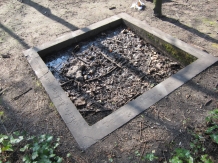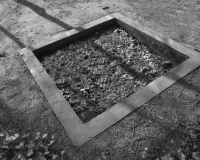Mary Magdalene Fountain (La fontaine de Sainte-Marie-Madeleine)
A small fountain (2x2 meters) surrounded by a grey granite edge is found in the Brussels Park (parc de Bruxelles or sometimes Parc royal (in French) or Warandepark (in Dutch)) (previously known as the Palace Park or the Ducal Park). Currently, the fountain has no water and its interior surface is covered up with soil.
The park is located in the center of the city and has an area of 11 hectares. It is surrounded by Rue Royale (Royal street), Rue de la Loi (Law street), Rue Ducale (Ducal street), and Place des Palais (Palace square).
On June 21, 1971, the park was recognized as the national heritage of the Brussels region (Région de Bruxelles-Capitale) and restoration work commenced, which was completed in 2001.
The fountain is located next to the bust of Peter I and the sculpture of Mary Magdalene which gave the name to the fountain. A Latin inscription runs along the granite edge reading: “Die 16 Aprilis anni 1717 / Petrus Alexiowitz Czar magnus Moscoviae Dux / insidens margini hujus fontis aquam illius nobilitavit / libato vino hora post meridiem tertia” (On April 16, 1717, Peter Alexeevich, the Tsar and the great Sovereign of Moscow, refined the water in this fountain by making a libation of wine while sitting here on the edge after two o’clock in the afternoon).
The exact meaning of the inscription is a matter of dispute. Probably, it refers to an incident that took place during a festival in the park on April 5/16, 1717. According to one version, in the midst of fun and an abundance of drinking, a member of Peter’s entourage jumped on the island in the fountain of Mary Magdalene. Peter followed him but landed in the water. Because of the amount of drinking, his stomach heaved and he vomited straight into the fountain. This anecdote is not correct, as the fountain is too small to have an island. It may be that the Tsar fell into one of the larger pools in the park.
According to another version, the Tsar refined the water by drinking wine while sitting on the edge of the fountain. The third version says that the Tsar put a bottle of wine into the water in the fountain to cool it down. Apparently, the Brussels magistrate decided to memorialize this event without getting into too much detail.
The fountain with the inscription dedicated to Peter the Great has inspired the installation of a bust of him nearby in the mid-19th century.
Next to the fountain, there is the sculpture of the penitent Mary Magdalene (Marie-Madeleine repentante). It is a marble figure of a lying woman with a book in a stone grotto. The statue was created by Jérôme Duquesnoy (1602–1654), a Brabant sculptor of the Mannerist Period who designed the famous Manneken-Pis standing in the center of Brussels.
According to an urban legend, during his visit to Brussels, Tsar Peter was invited to a dinner party at the King’s residence (although at that time, the Austrian Netherlands had no king). He was waited for for a long time, but he never showed up. When the next morning servants went to look for the missing Tsar, they found him sleeping in the arms of a local beauty in a ravine, just where the today’s park is situated.
The story about the lost Tsar and his accidental lover is a legend and is absent from the historical literature. The myth is based on the fact that between April 3/14 and 7/18, 1717, Peter I stayed in Brussels in the Emperor’s House (Maison de l’Empereur) — also known as the House of Charles V (Maison de Charles-Quint) — in the park. The building was then demolished in 1778.
Peter could well see the sculpture of Mary Magdalene as it had been made long before his visit, in the mid-17th century. Nowadays, the sculpture has been replaced with a copy and the original is kept in the Communal Museum in the so-called Spanish King’s House in the Grand Place in Brussels.




